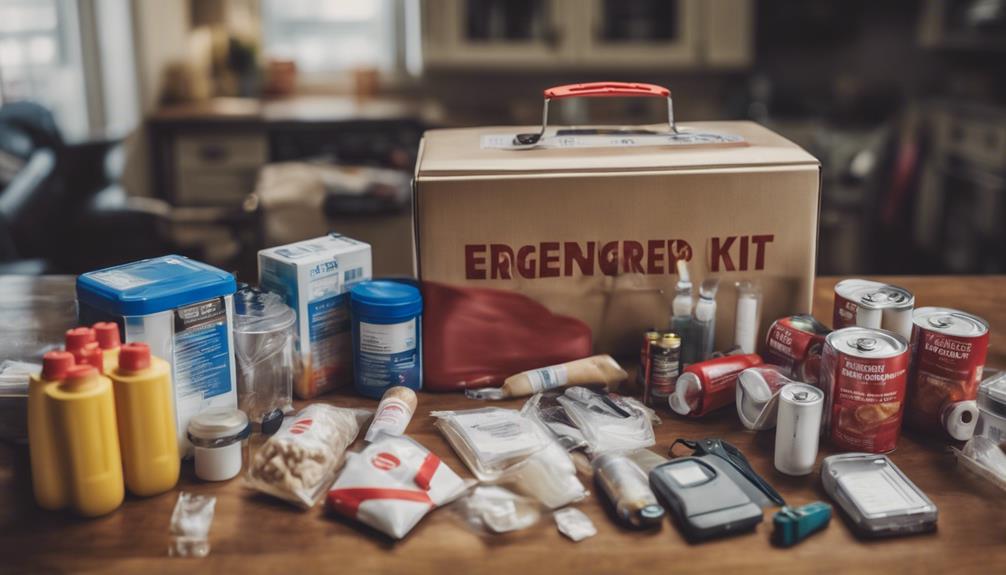In 2023, preppers are gearing up for a multitude of challenges. They brace for extreme weather events wreaking havoc on agriculture and essential services with power outages becoming commonplace. Food shortages loom, caused by erratic weather, pest invasions, and animal migration disruptions. Water scarcity crisis worsens due to prolonged droughts, necessitating conservation and alternative sources. Energy disruptions are feared as power grids falter under climate extremes. Medical emergencies are a focal point with stockpiling essential supplies, anticipating pandemics. Economic instability concerns loom large with job losses and market volatility. These proactive measures address potential crises on multiple fronts.
Key Takeaways
- Extreme weather events like heatwaves and wildfires
- Food shortages due to climate-related challenges
- Water scarcity from ongoing droughts and reduced rainfall
- Energy disruptions and power grid vulnerabilities
- Health and safety preparedness for global pandemics and medical emergencies
Extreme Weather Events
Prepare for the increasing frequency and severity of extreme weather events impacting global systems and daily life in 2023. Several years ago, thousands of heat records were shattered in Europe during the winter, signaling unprecedented shifts in weather patterns worldwide.
These extreme weather events aren't isolated incidents but part of a larger trend that's affecting agriculture, wildfires, and essential services like water and electricity. Municipalities are struggling to cope with the impact of extreme heat, with power lines buckling under the strain, leading to fires and widespread outages.
The repercussions of extreme weather events are far-reaching, with below-freezing temperatures causing system failures and rapidly igniting wildfires. Scientists remain perplexed by the recent erratic weather patterns, expressing concerns about the implications on agriculture, daily routines, and the potential for diseases, famine, and conflicts arising from these unpredictable changes.
Stay informed and prepared for the unpredictable nature of extreme weather events in 2023.
Food Shortages

As extreme weather events continue to impact global systems and daily life in 2023, preppers are bracing for the looming threat of food shortages caused by a combination of factors such as droughts, crop failures, and shifting agricultural patterns.
The global agricultural landscape is facing significant challenges due to temperature extremes, leading to ongoing food shortages. Excessive rainfall, a consequence of these extremes, fosters insect infestations, contributing to shortages of essential grains and grasses critical for food production.
Moreover, the fluctuating temperatures are prompting shifts in animal migratory patterns, disrupting traditional food sources. The impacts of temperature fluctuations on crops are also worrisome, increasing the vulnerability of harvests to diseases and infestations, further jeopardizing food supplies.
Preppers are recognizing the urgency of these interconnected issues and are taking proactive measures to safeguard their food security in the face of these challenges, such as stockpiling essentials and investing in water purification systems to handle the increasing demand for gallons of water.
Water Scarcity

Water scarcity poses a critical challenge for preppers in 2023 due to ongoing droughts and reduced rainfall patterns. One thing preppers are doing to address this issue is storing water, implementing conservation measures, and exploring alternative sources. Providing useful information, here is a table showcasing key aspects of water scarcity preppers are concerned about:
| Concerns | Preppers' Actions | Impacts |
|---|---|---|
| Reduced rainfall | Storing water | Impact on agriculture |
| Increasing water demand | Implementing conservation measures | Disruption in daily life |
| Contamination risks | Exploring alternative water sources | Potential conflicts over resources |
Last year's challenges highlighted the importance of planning for disruptions in municipal water supplies, contamination risks, and conflicts over limited water resources. Preppers focus on water purification methods and storage solutions to guarantee access to clean drinking water during scarcity events.
Energy Disruptions

Amid increasing extreme weather events, energy disruptions have become a growing concern for preppers in 2023. When it comes to ensuring your preparedness for potential energy disruptions, let's discuss some critical points to take into account:
- Power lines sagging in hot temperatures lead to fires and outages, posing a risk to energy supply.
- Below freezing temperatures can cause system failures, exacerbating energy disruptions.
- Extreme weather events like wildfires are sparked quickly, impacting energy infrastructure.
- Energy disruptions are increasing during extreme heat, causing municipal water and electricity failures.
- Preparing for energy disruptions is vital to guarantee access to essential services during extreme weather events.
Being aware of these factors is just one part of being ready for potential energy disruptions. It's important to have a plan in place to secure alternative energy sources and safeguard your access to crucial services.
Stay informed and proactive to mitigate the impact of energy disruptions on your prepping efforts.
Medical Emergencies

Preparing for medical emergencies is a top priority for preppers, encompassing a range of scenarios from pandemics to accidents. The concerns revolve around the potential strain on healthcare systems during crises, leading preppers to focus on ensuring access to essential medical supplies, medications, and healthcare services.
To address these worries, preppers engage in first aid training, stockpile vital medicines, and assemble thorough emergency medical kits. Natural disasters, infectious disease outbreaks, and unforeseen accidents are among the top medical emergencies preppers anticipate. The emphasis lies on self-sufficiency in medical care, allowing preppers to address common injuries or illnesses effectively in emergency situations.
Economic Instability

You're likely to face risks of job loss as economic instability looms in 2023.
Inflation could hit hard, affecting the prices of goods and services you rely on daily.
Additionally, brace yourself for stock market volatility that might impact your investments and financial security.
Job Loss Risks
With economic instability on the rise, job loss risks have become a prominent concern for preppers in 2023. As individuals face the looming threat of unemployment, they're taking proactive steps to safeguard their financial well-being.
Here are five key factors contributing to the heightened worries about job loss risks:
- Economic Instability: Factors such as inflation, supply chain disruptions, and company closures are destabilizing the job market.
- Unemployment Rates: The possibility of a significant increase in unemployment rates is causing financial strain and uncertainty for many.
- Potential Layoffs: Preppers are bracing themselves for potential layoffs, reduced working hours, or shifts in their industries.
- Market Fluctuations: Economic downturns and market fluctuations can exacerbate job loss risks, necessitating the need for income security measures.
- Preparation Strategies: To mitigate the impact of job loss, individuals are focusing on building emergency savings, acquiring new skills, exploring alternative income sources, and adapting to changing economic landscapes.
Inflation Impact
In 2023, preppers are bracing themselves for the economic instability caused by the impact of inflation. The rising inflation rates can erode the purchasing power of money, leading to increased prices of goods and services. To combat this, preppers are stocking up on essential items before prices surge, recognizing the potential for shortages of key resources. Economic instability due to inflation highlights the necessity of securing necessary supplies in advance to navigate potential hardships. Preppers are actively investing in tangible assets like food, water, and other essentials that may become more expensive as inflation looms.
| Inflation Impact | Prepper Actions |
|---|---|
| Erosion of purchasing power | Stocking up on essential items |
| Increased prices of goods | Investing in tangible assets |
| Shortages of key resources | Securing necessary supplies |
| Financial hardships | Mitigating effects by proactive preparation |
Stock Market Volatility
Amidst the looming specter of economic instability, preppers are gearing up for potential stock market volatility in 2023. The uncertainties in the global economy have sparked concerns among preppers, leading them to take proactive steps to protect themselves from the potential impacts of market fluctuations.
Here are five key points to ponder:
- Economic instability can trigger market crashes and currency devaluations, prompting preppers to brace for financial disruptions.
- Stock market volatility may result in job losses, reduced investments, and a slowdown in economic growth, motivating preppers to secure their assets.
- Preppers anticipate challenges like inflation, supply chain disruptions, and increased living costs due to stock market instability.
- Concerns about market fluctuations are driving preppers to diversify their portfolios, invest in tangible assets, and develop resilient financial strategies.
- The need for preparedness underscores the importance of staying informed, adaptable, and proactive in addressing potential stock market turbulence in 2023.
Social Unrest

Preppers preparing for potential social unrest in 2023 are focusing on securing their homes and stockpiling essential resources. The concerns driving this preparation stem from the potential triggers of social unrest, such as economic instability, political turmoil, and civil unrest. The fear of disruptions in the supply chains leading to scarcity of resources and breakdowns in law and order is prevalent among preppers. Anticipating outcomes like protests, riots, looting, and violence, individuals are strategizing to fortify their homes, accumulate food and water supplies, and equip themselves for self-defense. Social unrest can be further fueled by compounding factors like natural disasters, pandemic-related issues, or escalating political tensions.
| Strategies for Dealing with Social Unrest | ||||
|---|---|---|---|---|
| Secure homes to prevent intrusions | Stockpile food and water | Prepare for self-defense | Stay informed through news sources | Establish community support systems |
Cybersecurity Threats

With the rise in cyber threats targeting critical infrastructure and personal data, preparations for potential cyber attacks are becoming increasingly essential for safeguarding against disruptions in essential services and national security.
As a prepper, staying vigilant against cybersecurity threats is paramount in today's digital world. Here are some key concerns and preparations regarding cybersecurity threats:
- Preppers are bracing for ransomware attacks on vital services such as water, electricity, and transportation.
- Anticipated disruptions in communication systems, financial institutions, and supply chains due to cyber threats are a significant worry.
- The potential for cyber warfare impacting national security and causing widespread chaos is a top concern for preppers.
- Securing digital assets, implementing robust cybersecurity measures, and developing contingency plans for cyber emergencies are top priorities.
- Preppers are focusing on enhancing their knowledge of cybersecurity best practices to mitigate risks and protect against potential cyber attacks.
Infrastructure Failures

You must consider the vulnerabilities in the power grid that can lead to widespread outages, disrupting essential services.
Communication breakdowns during infrastructure failures can exacerbate the situation, making it difficult to coordinate responses and assistance.
Being prepared for these scenarios is vital to guarantee your safety and well-being in the face of potential infrastructure failures.
Power Grid Vulnerabilities
Municipal water and electricity failures are on the rise, underscoring the vulnerabilities present in the power grid infrastructure. As extreme heat becomes more common, these failures are increasing, shedding light on the challenges faced by the power grid.
Power lines, susceptible to sagging under extreme weather conditions, pose a significant risk of sparking fires and causing widespread outages, disrupting daily life and compromising safety. Additionally, below freezing temperatures can trigger system failures within the power grid infrastructure, especially concerning during the winter months.
The occurrence of extreme weather events, such as wildfires rapidly ignited by power line issues, further accentuates the critical need to address vulnerabilities in the power grid. The shifting weather patterns affecting the power grid highlight the necessity for preppers to brace for potential disruptions in electricity supply and take proactive measures to bolster resilience.
Communication Breakdowns
During infrastructure failures, communication breakdowns can result in a lack of essential information dissemination. This breakdown can hinder emergency response coordination, as the absence of reliable communication channels impedes the flow of critical information.
Disruptions in internet, phone, and radio communications caused by infrastructure failures can severely impact access to important updates and instructions during emergencies. Inadequate communication systems in times of disasters not only delay rescue efforts but also contribute to increased confusion among affected individuals.
To prepare for such scenarios, preppers invest in alternative communication devices like radios and satellite phones, ensuring they have reliable means of staying connected when traditional channels fail. By prioritizing communication preparedness, preppers aim to mitigate the risks associated with infrastructure failures and safeguard their ability to receive and transmit essential information when it matters most.
Global Pandemics

Preppers are actively preparing for the possibility of a global pandemic in 2023, driven by the lessons learned from past outbreaks like COVID-19.
Concerns surrounding global pandemics include the rapid transmission of infectious diseases, the potential overwhelming of healthcare systems, and shortages of critical medical supplies.
To address these worries, preppers are focusing on stockpiling essential items such as masks, sanitizers, medications, and non-perishable food in anticipation of a pandemic scenario.
Drawing from insights gained from previous health crises, preppers emphasize the importance of health maintenance, stringent hygiene practices, and the implementation of isolation measures to safeguard against potential risks.
The primary objective behind prepping for a global pandemic is to promote self-reliance, reduce exposure to external threats, and maintain the continuous preservation of health and safety amidst uncertain circumstances.
Frequently Asked Questions
What Percent of Americans Are Preppers?
Approximately 3% of Americans identify as preppers, according to a survey by the Washington Post, translating to around 9 million actively preparing for various disaster scenarios.
Preppers engage in stockpiling food, learning survival skills, and creating emergency plans. Reasons for prepping range from concerns about natural disasters, economic collapse, pandemics, to societal unrest.
The popularity of prepping has risen due to increased awareness of potential threats and the necessity for self-reliance.
Who Are the People Who Prepare for the End of the World?
As someone who prepares for the end of the world, you're part of a diverse group that values self-sufficiency and readiness. Whether driven by a general unease about the future or specific concerns like societal instability or environmental disasters, your focus on stockpiling essentials and honing survival skills sets you apart.
Through your preparedness efforts, you strive to guarantee your survival in the face of catastrophic events, embodying the principles of resilience and foresight.
What Are the Prepper Priorities?
When considering prepper priorities, you must focus on key areas such as stocking up on food, water, medical supplies, and energy sources for resilience during disasters.
Ensuring homes and lands are secure against extreme weather events like flooding, snow, or heatwaves is essential.
Preparing for potential shortages by insulating homes, securing alternative energy sources, and stocking up on essential supplies is vital.
Learning from ancestral practices and hardening homes against historical weather extremes aids in mitigating climate change challenges.
What Kind of Person Is a Prepper?
A prepper is someone who actively prepares for emergencies, disasters, and societal disruptions. They prioritize self-reliance, emergency readiness, and sustainability in lifestyle choices.
Preppers often stockpile food, water, medical supplies, and essential resources to guarantee survival in crises. These individuals may also develop skills in first aid, self-defense, gardening, and alternative energy sources.
Preppers come from diverse backgrounds and professions but are united by their belief in preparedness for unexpected events.
What are the Current Top Concerns for Preppers in 2023?
In the world of preppers survival trends 2023, the top concerns include food and water security, natural disaster preparedness, cyber attacks, and global political instability. Preppers are focusing on sustainable living, off-grid solutions, and self-defense training to address these worries in the coming year.
Conclusion
As preppers gear up for potential challenges in 2023, the top concerns include:
- Extreme weather events
- Food shortages
- Water scarcity
- Energy disruptions
- Medical emergencies
- Social unrest
- Cybersecurity threats
- Infrastructure failures
- Global pandemics
Are you prepared for the uncertainties that lie ahead? Stay informed, stay alert, and stay ready to face whatever may come your way in the future.










